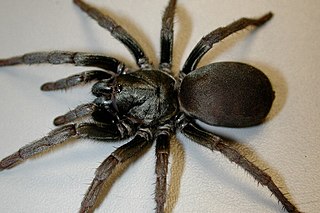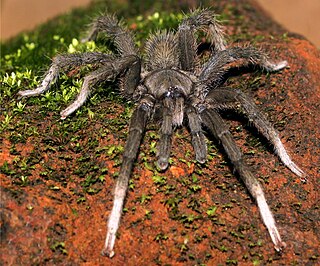
Nemesiidae is a family of mygalomorph spiders first described by Eugène Simon in 1889, and raised to family status in 1985. Before becoming its own family, it was considered part of "Dipluridae". The family is sometimes referred to as wishbone spiders due to the shape of their burrows.

Annandaliella travancorica is a species of tarantula spider found in the Western Ghats of India. It was the first of three members of the genus Annandaliella to be described, therefore the type species.

Annandaliella is a genus of tarantulas that was first described by A. S. Hirst in 1909. As of December 2019 it contains three species endemic to India: A. ernakulamensis, A. pectinifera, and A. travancorica. They are selenogyrid tarantulas, meaning they have a stridulating organ on the inner side of the chelicerae.

Sason is a genus of bark-dwelling brushed trapdoor spiders first described by Eugène Simon in 1887. It is distributed from the Seychelles through India to northern Australia. The closest related genus seems to be the monotypic Paracenobiopelma.

Idiops is a genus of armored trapdoor spiders that was first described by Josef Anton Maximilian Perty in 1833. It is the type genus of the spurred trapdoor spiders, Idiopidae. Idiops is also the most species-rich genus of the family, and is found at widely separated locations in the Neotropics, Afrotropics, Indomalaya and the Middle East. Females live in tubular burrows lined with a thick layer of white silk. These typically have a D-shaped lid that fits into the entrance like a cork, and some burrows have two entrances. The lid may consist of mud, moss or lichen, which is bound below by a thick layer of silk. As in all genera of this family, the anterior lateral eyes (ALE) are situated near the clypeal margin, far in front of the remaining six eyes, which are arranged in a tight group. The males which are smaller in size, wander about or occasionally live in burrows. Like other mygalomorphs, they are relatively large and long-lived. Forest clearance and agricultural practices that loosen the soil and enhance erosion, besides soil removal for brick making have been pointed out as serious threats to some Indian species. Species ranges are poorly known – in India for instance, most species are known only from their type localities.
Fijocrypta is a monotypic genus of South Pacific brushed trapdoor spiders containing the single species, Fijocrypta vitilevu. Both genus and species were first described by Robert Raven in 1994, and they have only been found in Fiji. It was first found in rainforests in the eastern highlands of Viti Levu, the largest island in Fiji, from which the species name is derived. The genus name is derived from "Fiji" and the Latin word cryptus, meaning "hidden".
Neoheterophrictus uttarakannada is a species of spiders in the genus Neoheterophrictus from India. It was first described in 2012 by Manju Siliwal, Neha Gupta, & Robert John Raven. Its name comes from the place where it was discovered, Uttara Kannada.
Neoheterophrictus sahyadri is a spider species in the genus Neoheterophrictus. It was first described in 2012 by Manju Siliwal, Neha Gupta, and Robert John Raven. Its name "sahyadri" comes from the vernacular name for the Western Ghats, a mountain range in India where it was discovered.

Neoheterophrictus is a genus of tarantula in the family Theraphosidae. It comprises 8 species, all found in India.
Neoheterophrictus bhori is a species of tarantula. It is native to Parambiculam, Western Ghats, Cochin province, India, in present-day Kerala state.
Neoheterophrictus amboli is a species of theraphosid spiders, which is found in India.

Neoheterophrictus smithi is a species of tarantulas, native to India.

Poecilotheria rufilata, also known as the red slate ornamental, reddish parachute spider, Travancore slate-red, or rufus parachute spider, is an arboreal tarantula. It is endemic to South Western Ghats of India. It is classed as "endangered", threatened by habitat loss and smuggling for the pet trade.
Poecilotheria tigrinawesseli, also known as Wessel's tiger ornamental or Anantagiri's parachute spider, is an arboreal tarantula. It is endemic to Eastern Ghats of India and known from six locations around Andhra Pradesh.
Neoheterophrictus madraspatanus is a species of spider in the family Theraphosidae, found in India.
Adelonychia halyi is a species of spider of the genus Adelonychia. It is endemic to Sri Lanka. Differences from the type species Adelonychia walshi include a large fovea and a less distinct abdominal pattern. The male is more hairy than female, with a slightly elevated spine. It was first described from the Nuwara Eliya area.
Plesiophrictus is a genus of tarantulas that was first described by Reginald Innes Pocock in 1899.
Tigidia is a genus of brushed trapdoor spiders first described by Eugène Simon in 1892.

Stenaelurillus wandae is a species of jumping spider in the genus Stenaelurillus that lives in India. It was first described in 2020 by Dmitri Logunov. The spider is medium-sized, with a carapace between 2.95 and 3.35 mm long and an abdomen between 2.8 and 3.5 mm long. The female is larger than the male. The colouration differs between them too, with the male having two white stripes on the carapace while the female has a pattern formed of brown and white scales. The chelicerae, clypeus, legs, pedipalps and spinnerets are generally yellow, although they may be yellow-brown on the male. The spider is distinguished from others in the area by the lack of a pocket in the epigyne of the female and the forked appendage, with different length tines, on the palpal bulb of the male.
Pochyta tendicula is a species of jumping spider in the genus Pochyta that lives in Gabon. A small spider, it was first described in 2021 by Wanda Wesołowska and Tamás Szűts. It has a light brown oval cephalothorax that is typically 2.4 mm long and has eyes that are surrounded by dark rings. It has an ovoid abdomen, typically 2.2 mm long, that is generally greyish-beige on top and grey underneath. Its front pair of legs are longer than the others and marked with long spines. The male has distinctive copulatory organs, with a long embolus that projects from a small palpal bulb, and a small curved spike in the palpal tibia called a retrolateral tibial apophysis. The female has not been described.







